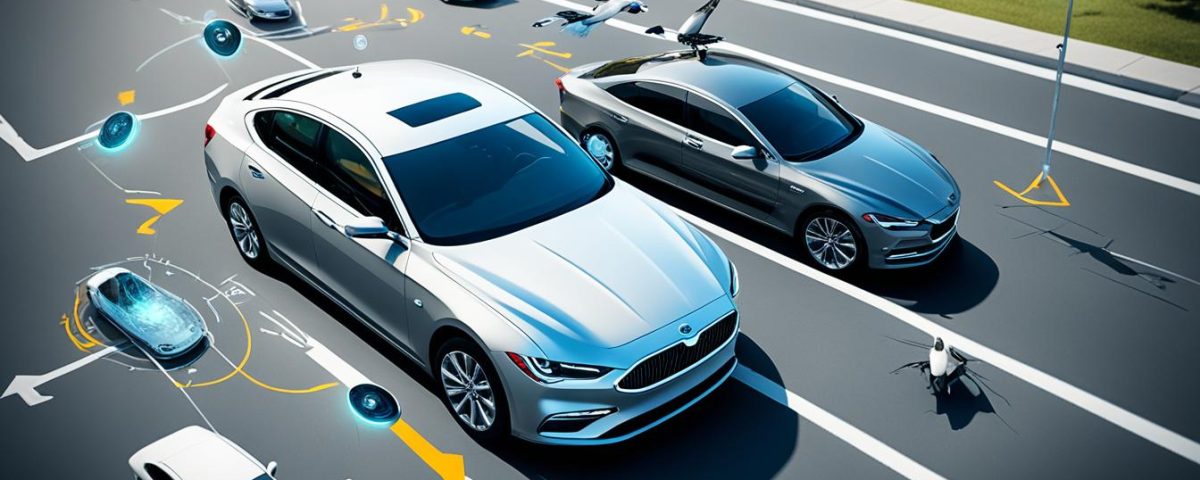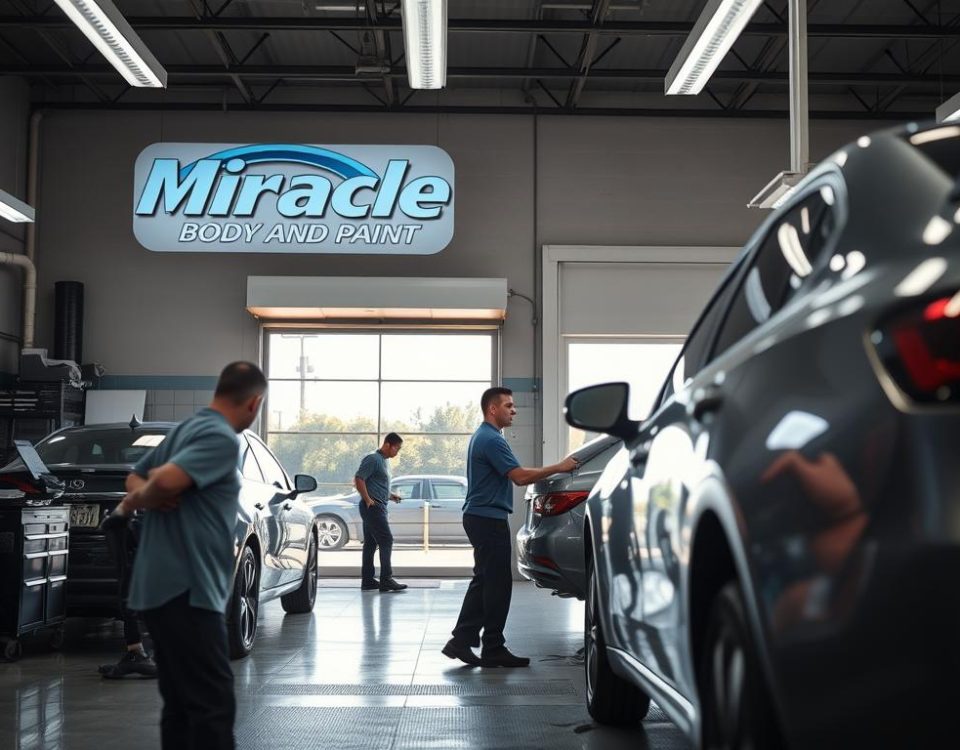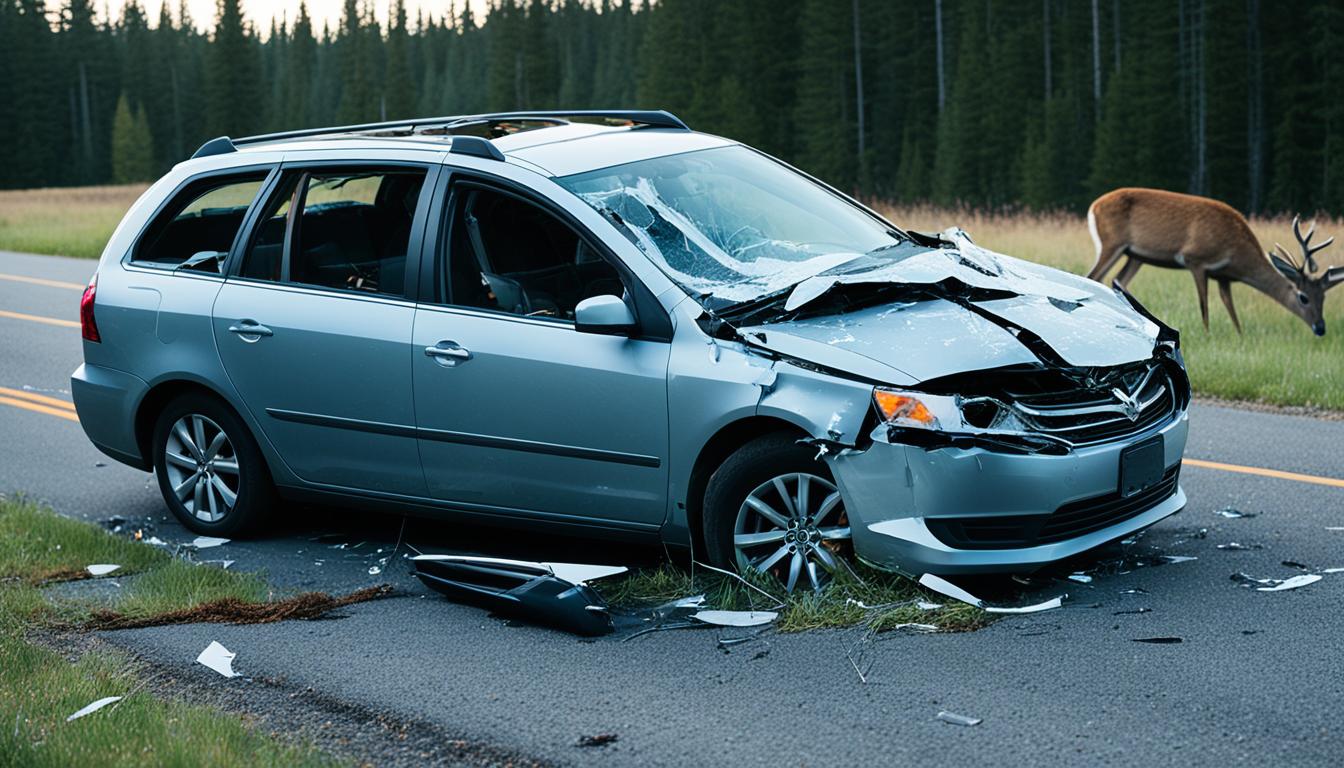
Dealing with Deer Collisions: Prevention and Repair
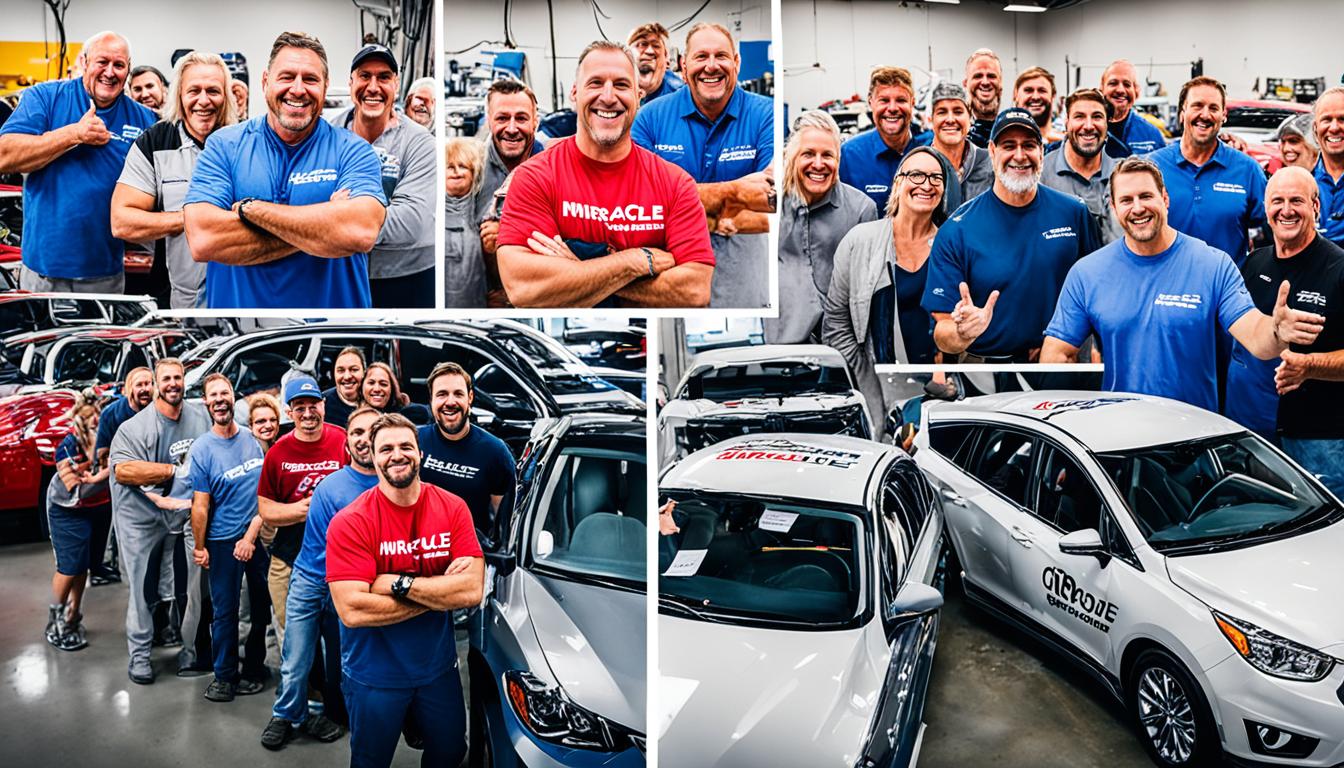
Real Customer Testimonials: Why Choose Miracle Body and Paint
In a crash, today’s safety features are vital for protecting everyone inside. These systems help avoid crashes and add extra safety layers. They include things like adaptive headlights, lane assist, and shatterproof glass. Also, auto stop in emergencies, alerts for cars in your blind spots, and cameras to help back up safely.
Key Takeaways:
- Modern collision safety features are designed to protect passengers in the event of a collision.
- These safety systems work together to prevent collisions and provide an additional layer of protection.
- Common modern safety features include adaptive lighting, lane keeping assist, blind spot detection, and shatter-resistant glass.
- Automatic braking, rear cross-traffic alerts, automatic crash notifications, and rearview video systems or backup cameras are additional safety features that can help prevent accidents and protect occupants.
- Choosing a vehicle with advanced collision safety features is crucial for ensuring the well-being of passengers and reducing the severity of injuries during a collision.
New Car Safety Features
Car makers are adding more safety tech to their models than ever before. These features aim to make driving safer by preventing accidents. We will explore the important safety features in today’s new cars.
All-Season Tires
All-season tires are a crucial safety component. They offer better grip on the road in any weather. This design cuts down on slipping, helping drivers to stop more safely.
Adaptive Lighting
Adaptive lighting is a high-tech feature that adjusts how bright and where headlights shine. It makes seeing in the dark clearer. This cuts down on the chances of hitting something unexpected at night.
Lane Keeping Assist and Centering Assist
Lane keeping assist and centering assist keep drivers on track, quite literally. They offer slight steering corrections to prevent drifting. If you’re moving out of your lane by mistake, they’ll warn you.
Blind Spot Detection
Blind spot detection is a system that keeps an eye on spots you might miss. It alerts you if a vehicle is hidden in your blind spot. This makes changing lanes safer by warning you of unseen dangers.
Shatter-Resistant Glass
Shatter-resistant glass makes windshields stronger. It stops the glass from breaking into sharp pieces. This protects anyone inside the car from glass-related injuries during an accident.
Lane Departure Warning
Lane departure warning uses tech to spot if you’re drifting without signaling. It then warns you to stay within your lane. This warning can help avoid accidents by keeping you in the right lane.
Automatic Braking Systems
Automatic brakes go off to stop a crash if you don’t react fast enough. They can lessen the impact of a crash or stop it altogether. This tech is key in keeping everyone safe on the road.
These safety techs team up to lessen crashes and safeguard everyone inside the car. They add an important safety layer for families and drivers. When buying a new car, looking for these features is crucial for the best protection on the road.
Mandatory Car Safety Features
When talking about car safety, certain features are a must in all vehicles. They aim to safeguard people and make the vehicle safer. Let’s dig into these vital safety components that cars shouldn’t miss.
1. Seatbelts
Seatbelts rank high as a crucial car safety feature. They prevent passengers from moving forward in a crash. Proven by saving many lives yearly, they’re fundamental for safety.
2. Airbags
Airbags act as a barrier between the car’s interior and its occupants. They inflate quickly to protect against severe head and chest injuries. Working alongside seatbelts, they add another layer of defense.
3. Tire Pressure Monitoring
Well-inflated tires are essential for your car to run smoothly and handle well. Tire pressure monitoring alerts you if the pressure is too low. This not only makes driving safer but also saves gas and lengthens your tires’ life.
4. Inside Trunk Monitor
The inside trunk monitor ensures no one gets stuck in a locked trunk. It lets people inside communicate and call for help. This feature could save a life in an emergency.
5. Electronic Stability Control
Electronic stability control (ESC) aids in keeping your car under control on slippery roads. It stops the car from skidding or rolling by adjusting braking and engine power. ESC boosts handling, cutting down on accidents.
These crucial car safety features are a mainstay in new vehicles for a reason. Seatbelts and airbags fight injuries from crashes, tire monitors keep performance at its peak, trunk monitors aid in emergencies, and stability control avoids precarious driving situations. Together, they make for safer travels, looking out for everyone in the car.
The Importance of Car Safety Features
Car safety features are key in stopping accidents and making crashes less severe. Studies show they lower the risk of dangerous accidents by 49% and the chance of getting hurt by 53%. This proves how vital it is to focus on safety when choosing a car.
Modern safety tools work to make driving safer and prevent accidents. These features protect drivers, passengers, and people on the road. With the latest safety technologies, car makers are making our roads safer and saving lives.
Picking a car with good safety features is crucial for keeping yourself and others safe. Advanced safety technologies lower your risk on the road. They also give you peace of mind, knowing your car is designed to protect you.
Car safety features are fundamental for keeping vehicles safe and preventing accidents. They give drivers the confidence to drive without fear, cutting down the chances of crashes. Recognizing the value of these features helps make our roads safer for everyone.
Active vs Passive Car Safety Features
Car safety has two main types: active and passive features. Both are important for keeping us safe on the road and avoiding accidents.
Active features help stop accidents by making drivers more alert and less prone to mistakes. They act in real-time to help drivers. Examples include:
- Adaptive cruise control keeps a safe distance from cars ahead.
- Blind spot warning tells drivers about nearby cars they can’t see.
- Lane departure warning alerts drivers if they start to drift, avoiding crashes from lane changes.
- Obstacle detection uses sensors to spot hazards and warn drivers, preventing accidents.
Passive features focus on lessening injuries during a crash. They guard against harm once a collision happens. They involve:
- Seat belts keep people in place, stopping them from flying out.
- Airbags inflate during a crash to protect the head and chest.
- Crumple zones take in the crash’s force, ensuring less harm to those inside.
- Advanced braking helps the car stop faster, avoiding crashes or reducing their impact.
Both kinds of safety features are crucial for our safety. They work together to prevent accidents and protect us if one happens.
Looking at the image below will help you see how these features collaborate:
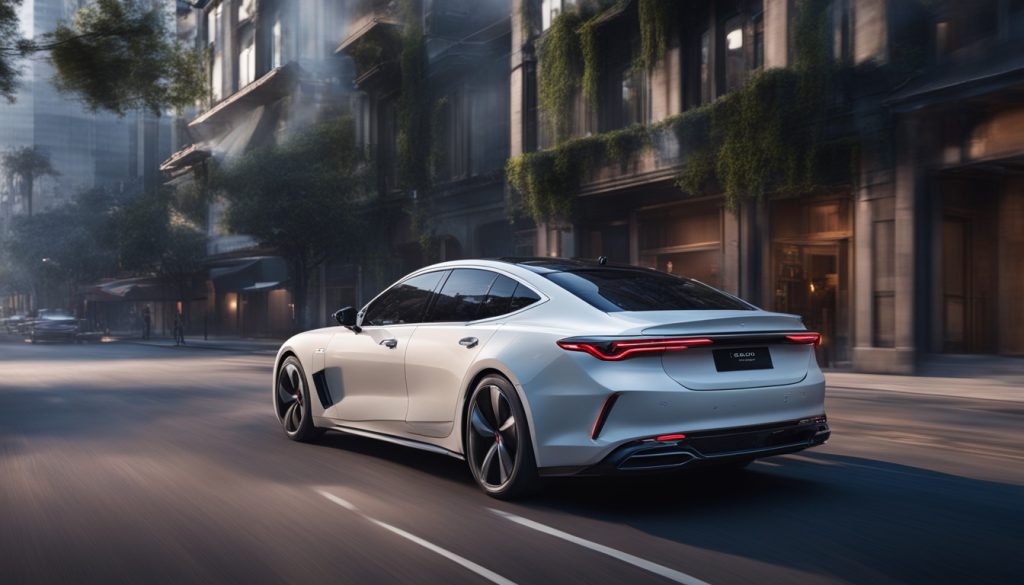
This image illustrates a car’s active and passive safety features, working in harmony to stop accidents and lower injury risks.
Braking Safety Features
Braking safety features are key for driving safely and looking out for others on the road. These systems make braking better, helping you stay in control. This keeps everyone safe while driving.
Anti-Lock Braking Systems (ABS)
The anti-lock braking system (ABS) is crucial for safety. ABS stops the wheels from locking up. It does this by quickly adjusting the brakes. This way, you can steer while stopping quickly. It’s a big help in sudden stops, reducing skidding and keeping you safe.
Traction Control Systems
Traction control systems work with ABS to prevent sliding. They manage the power going to your wheels, improving grip. This is very useful on wet or slippery roads. It helps keep your vehicle stable, reducing the risk of sliding or spinning out.
Electronic Stability Control Systems
Electronic stability control systems (ESC) are important too. ESC helps avoid sliding or losing control. It does this by adjusting the brakes on each wheel separately. This keeps your car going where you want, even in sudden turns or on dangerous roads.
Brake Assistance Systems
Modern cars also have brake assistance systems. These give extra power to your brakes in emergencies. They make stopping quickly and safely easier. These systems cut down on the distance you need to stop, which is a great safety addition.
All these features work together to keep you safe on the road. Knowing your car has these technologies can give you peace of mind. They’re there to stop accidents and keep everyone safe.
Parking Safety Features
Parking is all about safety, especially in today’s world. Car makers are adding high-tech features to help drivers park without accidents. These tools make parking safer and smoother.
The reverse camera is a key part. It shows the area behind the car, helping drivers see what’s not in their direct view. They can spot anything in their way and avoid hitting it while backing up.
Parking sensors also play a big role. They detect things close to the car using sound waves. If something’s too near, they warn the driver. This is especially useful for fitting into tight spots without hitting anything.
Then, there are rear cross-traffic alerts to watch out for sideways traffic. They use sensors to see cars coming while you’re backing up. This technology gives a heads-up to drivers to avoid accidents.
With these features, drivers and pedestrians are safer when parking. Together, they make sure parking lots and streets are safer for everyone.
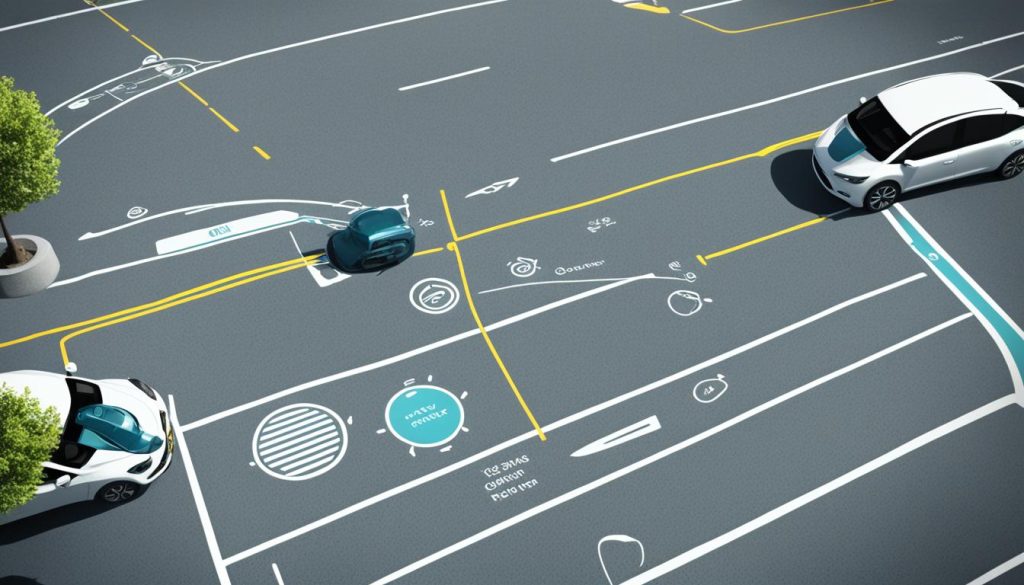
Conclusion
Modern collision safety features are key in keeping us safe in accidents. They include new car safety elements, must-have safety parts, and more. These work together to make our cars safer and help us avoid crashes.
When we buy a car, it’s vital to pick one with these safety features. This keeps us and others safe. With tech getting better, cars offer more safety than ever before, making the road a safer place for all.
Choosing a car with good safety tech is about more than just personal safety. It’s also about being responsible in our communities. By choosing safety, we help lower accidents, lessen injuries, and make roads safer for everyone.


